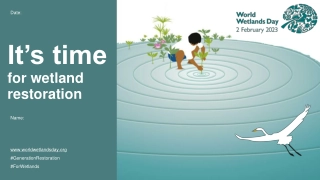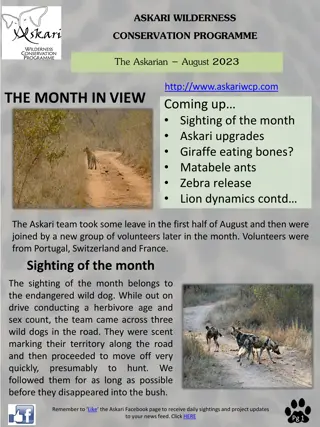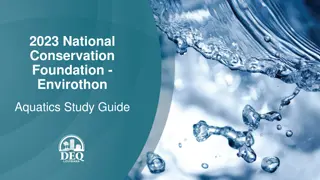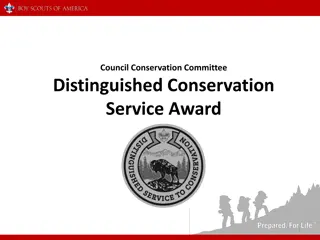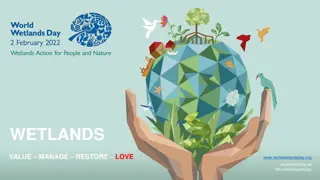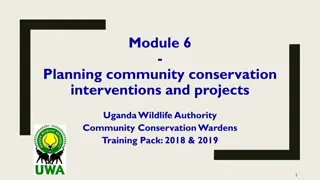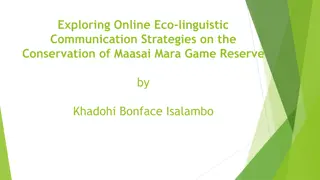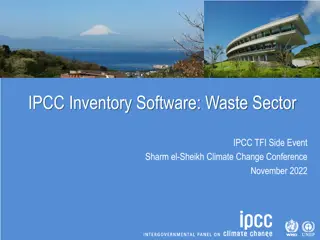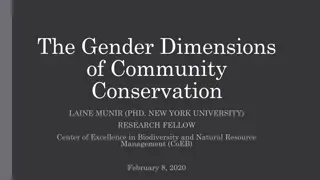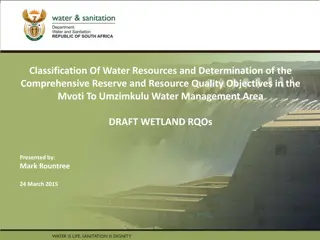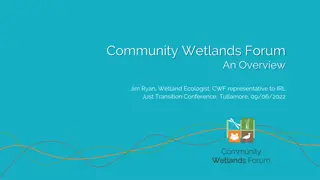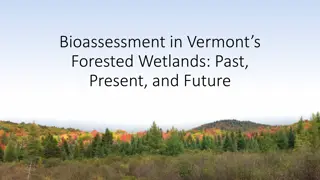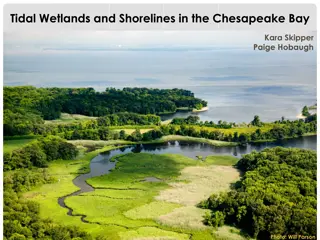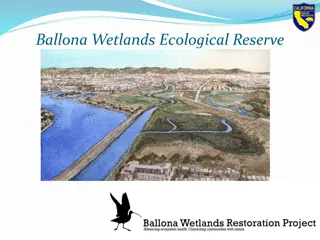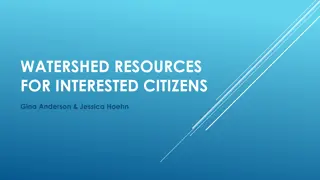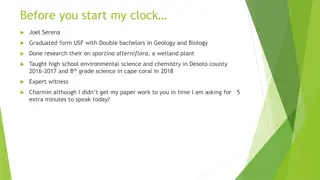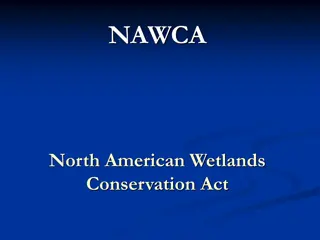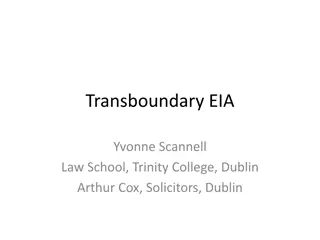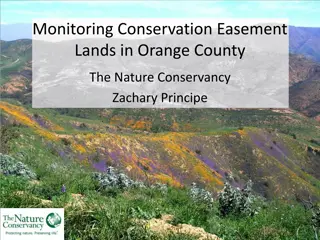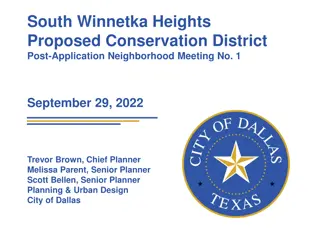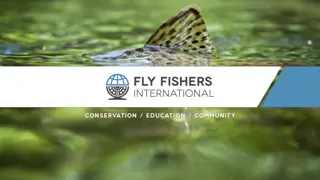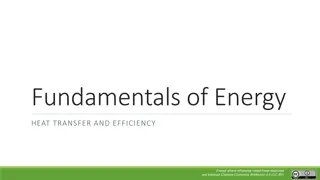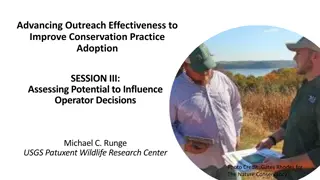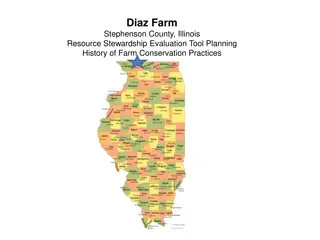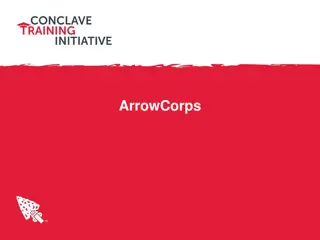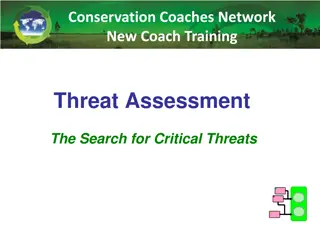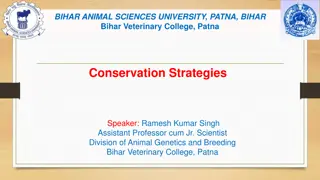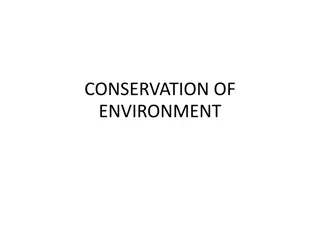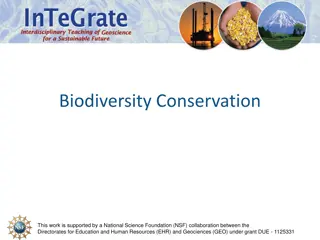Restoring Wetlands: Vital for Our Future
Learn about the importance of wetlands, the urgency of restoration, and best practices for the preservation of these critical ecosystems. Discover how wetlands support biodiversity, provide essential services to humanity, and can be restored through community involvement and sustainable practices.
3 views • 18 slides
NRCS Programs Update
The Inflation Reduction Act (IRA) provides $20 billion to support USDA's conservation programs focusing on climate-related benefits and agricultural resilience. It allocates funds for programs like the Environmental Quality Incentives Program, Agricultural Conservation Easement Program, Regional Con
2 views • 14 slides
Innovative Approach to Managing Environmental Challenges in River Catchments
A project led by John Bryden at Oxford University focuses on community modelling for rivers, enabling local people to use tools typically reserved for scientists. The initiative addresses issues faced by rivers through the INCA model, constructed wetlands, and community engagement. By creating wetla
9 views • 12 slides
Askari Wilderness Conservation Programme August 2023 Newsletter
The Askari Wilderness Conservation Programme's August 2023 newsletter highlights the team's encounters with endangered wild dogs, upgrades to the conservation area including the building of a waterhole, unique wildlife sightings like a giraffe eating bones, and observations of Matabele ants. Volunte
1 views • 5 slides
2023 National Conservation Foundation - Envirothon
Explore the intricate dynamics of aquatic ecosystems and wetlands conservation through this comprehensive study guide. Discover the importance of watersheds, the hydrologic cycle, aquatic food webs, energy flow at trophic levels, and common macroinvertebrates in Louisiana. Learn about different wetl
3 views • 27 slides
Effective Methods for Soil Conservation
Methods to reduce soil erosion and promote soil conservation include terracing, contour planting, strip cropping with cover crops, alley cropping, agroforestry, windbreaks, and conservation tillage practices such as no-till and minimum tillage. These methods help in minimizing soil erosion hotspots
2 views • 11 slides
Council Conservation Committee Distinguished Conservation Service Award
The Council Conservation Committee Distinguished Conservation Service Award is a prestigious recognition in scouting, involving projects, workbook completion, and assessment by a Council Board of Review. Councils must establish their own policies for administering the award. Scouts recognized with a
2 views • 20 slides
World Wetlands Day 2022: Taking Action for Wetlands Conservation
World Wetlands Day is an annual event celebrated on February 2nd to raise awareness about the importance of wetlands for people and the planet. This year's theme, "Wetlands Action for People and Nature," emphasizes the urgent need for increased investment in the conservation of wetlands to ensure th
2 views • 12 slides
Understanding Conservation Project Planning Basics
This module explores basic terminology in conservation project planning, focusing on key concepts like project, intervention, and community project. It delves into understanding the steps involved in planning for conservation projects, with a special emphasis on terminology and definitions essential
0 views • 44 slides
Strategies for Online Eco-Linguistic Communication in Maasai Mara Conservation
Maasai Mara faces threats from human encroachment, prompting conservation efforts. This study explores online eco-linguistic strategies for engaging the public in conservation activities. The importance of language in online communication to achieve ecological harmony is highlighted, emphasizing eco
0 views • 17 slides
IPCC Inventory Software Enhancements for Waste Sector Emissions Estimation
Explore the latest enhancements in the IPCC inventory software related to waste sector emissions estimation. Major updates include subnational disaggregation, Tier 3 methods, wetlands supplement, and improvements in worksheet structure and layout. The software allows for detailed estimation of green
2 views • 10 slides
Marine Conservation Governance in Raja Ampat, West Papua, Indonesia
Explore the dynamics of marine conservation governance in Raja Ampat, West Papua, Indonesia, with a focus on Sasi practices and the preliminary findings in the West Misool and South Misool districts. Discover the potential resources in Raja Ampat and the various types of marine conservation areas in
1 views • 22 slides
Exploring Gender Dynamics in Community Conservation
This research delves into the intricate relationship between gender and conservation efforts, emphasizing the impact of gender roles on biodiversity loss. It discusses gender essentialism, global gender perspectives in conservation, and presents case studies on Payment for Ecological Services (PES)
1 views • 11 slides
Comprehensive Water Resource Classification and Management in Mvoti to Umzimkulu
This presentation discusses the assessment and management of wetlands in the Mvoti Water Management Area through the establishment of Resource Quality Objectives. It highlights the importance of wetlands, key strategies for wetland management, and the prioritization of wetland conservation efforts b
2 views • 21 slides
Community Wetlands Forum Overview by Jim Ryan, Wetland Ecologist
The Community Wetlands Forum, represented by Jim Ryan, is a platform promoting community-led wetland conservation in Ireland. With a focus on biodiversity, conservation, and community well-being, the forum aims to foster collaboration, knowledge sharing, and inclusive participation among stakeholder
0 views • 10 slides
Bioassessment in Vermont's Forested Wetlands: Monitoring and Conservation Efforts
Vermont's Wetlands Program, part of the Department of Environmental Conservation, actively monitors and assesses the health of the state's wetlands. Utilizing bioassessment methods, they aim to support planning, regulatory activities, and restoration projects while tracking long-term trends in wetla
0 views • 17 slides
Tidal Wetlands and Shorelines in the Chesapeake Bay: Environmental Impact and Conservation Efforts
Tidal wetlands and shorelines in the Chesapeake Bay face pressures from water, land, storms, upland development, shoreline modification, and sea-level rise. Collaborative efforts like the Fish Habitat Action Team aim to highlight the importance of these ecosystems for fisheries. Projects focus on sy
0 views • 9 slides
Aquatic Treatment Systems for Wastewater Reclamation and Reuse
In aquatic systems, wastewater treatment involves bacterial metabolism and sedimentation, with aquatic plants playing a role in improving treatment capabilities. This article discusses the functions of aquatic plants in treatment systems and the categories of wetlands used for wastewater treatment,
1 views • 15 slides
Conservation Efforts and Restoration Plans for Ballona Wetlands
The Ballona Wetlands Ecological Reserve is undergoing long-term restoration planning to restore tidal circulation, provide diverse wetland habitats, and create new habitat areas for native species. Various initiatives and projects, such as the Dutch Slough Carbon Sequestration and the EIR Project Go
1 views • 15 slides
Watershed Resources for Interested Citizens
Explore a variety of resources related to watersheds, wetlands, and water monitoring, including tools provided by the U.S. Fish and Wildlife Services National Wetland Inventory. Learn about different types of wetlands, access the Indiana Watershed Group Finder for locating hydrologic unit codes, and
3 views • 18 slides
Protecting Wetlands: A Call to Deny Agricultural Rezoning
Joel Serena, a Geology and Biology graduate, urges the board to deny agricultural land rezoning based on environmental factors. Through images and compelling arguments, the detrimental effects of mining on wetlands like Horse Creek in Florida are highlighted. The plea is to safeguard existing sustai
0 views • 21 slides
North American Wetlands Conservation Act (NAWCA) Overview
The North American Wetlands Conservation Act (NAWCA) is a federal funding program established to protect and restore wetlands in North America. Through Joint Ventures, partners access funds for various projects across the region, with grants available for both standard and small projects. The act re
0 views • 15 slides
Transboundary Environmental Impact Assessment for Greenstar Development
The Transboundary Environmental Impact Assessment (EIA) conducted for the Greenstar Development project involving EU Member States A and B reveals potential environmental impacts like soil and waste deposition, polluted dredging material transfer, and altered currents affecting wetlands and flooding
0 views • 7 slides
Overview of 2014 Federal Farm Bill Provisions
The 2014 Federal Farm Bill introduced various amendments impacting conservation compliance, pollinator protection, the Conservation Reserve Program (CRP), and easement programs. Changes included recoupling federal crop insurance benefits to conservation requirements, extending pollinator protection
1 views • 25 slides
Empowering Communities for Wetlands and Bog Restoration Through Community Involvement
Empowering local communities for wetlands and bog restoration involves educating on the benefits of conservation, navigating through political challenges, and fostering community involvement. The Wetlands Forum and local networks aim to engage stakeholders in identifying potential sites and organizi
1 views • 12 slides
Conservation Easements and Monitoring in Orange County by The Nature Conservancy
The Nature Conservancy plays a vital role in monitoring and managing conservation easement lands in Orange County, ensuring the protection of conservation values and natural resources. Through the Irvine Ranch Conservation Easements, they uphold specific permitted and prohibited activities while tai
1 views • 19 slides
South Winnetka Heights Proposed Conservation District Post-Application Neighborhood Meeting
This document provides details about the post-application neighborhood meeting for the proposed conservation district in South Winnetka Heights, Dallas. The meeting aims to discuss development standards and architectural considerations chosen by the neighborhood, including driveways, curbing, front
1 views • 37 slides
Fly Fishers International: Preserving Fly Fishing Legacy and Conservation Efforts
Fly Fishers International is an international non-profit organization dedicated to supporting, enhancing, and preserving fly fishing opportunities through environmental stewardship, education, and conservation efforts. With a history dating back to the 1960s, they focus on educating individuals in c
0 views • 28 slides
Understanding Energy Efficiency and Conservation Fundamentals
This unit introduces basic terms related to energy, efficiency, and conservation, covering topics such as Efficiency and Conservation Energy, First and Second Law of Thermodynamics, and various heat transfer mechanisms. It emphasizes responsible energy use, focusing on efficiency, conservation, and
0 views • 14 slides
Enhancing Conservation Practice Adoption Through Decision Science and Behavioral Economics
Explore how decision science, descriptive and prescriptive decision theory, and behavioral economics play essential roles in influencing operator decisions for adopting conservation practices. The session delves into problem framing, action implementation, alternative development, consequence evalua
0 views • 10 slides
Threats to Biodiversity: Habitat Loss and Conservation Efforts
Habitat loss is a significant threat to species worldwide, with forests, swamps, plains, and other habitats disappearing due to human activities. The decline of black rhinos and the conservation efforts made to protect them illustrate the impact of such activities on wildlife populations. African Pa
2 views • 12 slides
Diaz Farm Conservation Journey in Illinois
Explore the 17-year conservation journey of Diaz Farm in Stephenson County, Illinois, led by Dan Diaz, focusing on sustainable land management practices and the use of Resource Stewardship Evaluation Tool for conservation planning. The farm's history, conservation engagement with various organizatio
0 views • 9 slides
Understanding Conservation and Taking Action
Explore the purpose of conservation and learn how to plan and execute conservation projects using local, regional, and national resources. Discover the legacy of the ArrowCorps service project and understand the difference between conservation and preservation. Identify conservation issues and resou
1 views • 12 slides
Conservation Challenges and Opportunities in the 2018 Farm Bill
The 2018 Farm Bill presents a battleground where conservation, environmental protection, and agricultural interests collide. Key issues include changes in the Clean Water Act, pesticide use, CAFO operations, NEPA requirements, and potential impacts on conservation programs like the Conservation Stew
0 views • 7 slides
Bath and North East Somerset: Rich Heritage and Conservation Efforts
Bath and North East Somerset boasts a rich and diverse historic environment, with over 6000 listed buildings, 36 conservation areas, and numerous archaeological sites. The Planning and Conservation Team is dedicated to managing development, preserving heritage assets, monitoring at-risk sites, and e
0 views • 6 slides
Understanding Threat Assessment in Conservation: Direct, Stress, and Indirect Threats
Within threat assessment for conservation, different types of threats are identified and categorized, including direct threats which are human-induced actions directly affecting conservation targets, stressors which result from biophysical impacts of actions on targets, and indirect threats contribu
0 views • 24 slides
Understanding Conservation Principles in Fluid Dynamics and Classical Mechanics
Conservation principles play a significant role in fluid dynamics and classical mechanics. In fluid dynamics, conservation of mass, momentum, and energy are crucial for understanding fluid behavior. Classical mechanics, on the other hand, relies on Newton's laws to describe motion and energy conserv
1 views • 46 slides
Conservation Strategies in Animal Sciences at Bihar Veterinary College
Principles of conservation in animal genetics and breeding involve maintaining optimum population size, preserving unique traits, and selecting diverse stock. Methods include in-situ and ex-situ conservation, with in-situ conservation being preferred for its genetic variability and adaptability bene
0 views • 21 slides
Sustainable Conservation Practices for a Greener Future
Introducing the concept of conservation, its aims, objectives, and the importance of sustainable development. The strategies for environmental conservation highlight the significance of special interest and total ecosystem policies. Emphasizing the use of renewable resources and strategies like redu
1 views • 9 slides
Understanding Biodiversity Conservation and Its Importance
Exploring the concept of biodiversity conservation supported by the National Science Foundation, this work delves into the impacts of human activities on biological diversity, compares current extinction rates with past events, evaluates species conservation priorities, and distinguishes between ex
0 views • 16 slides
